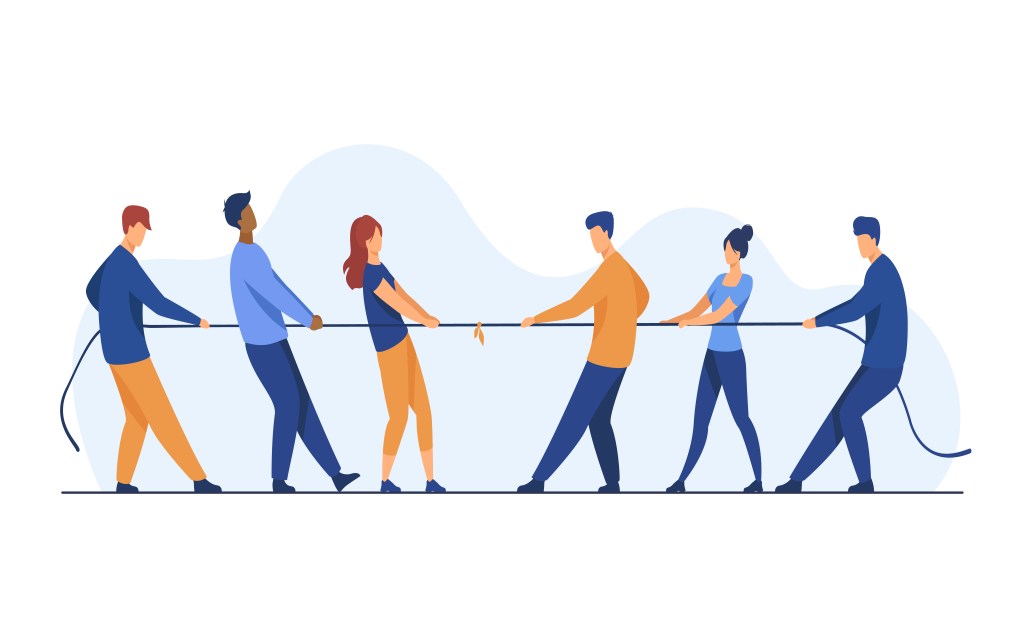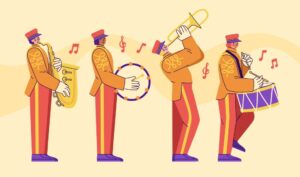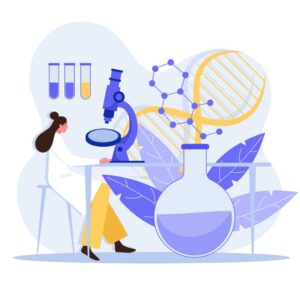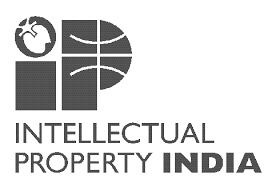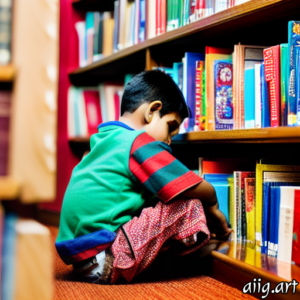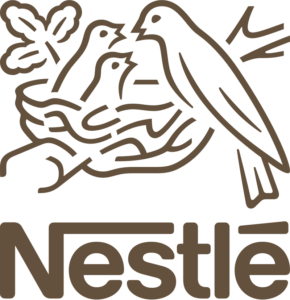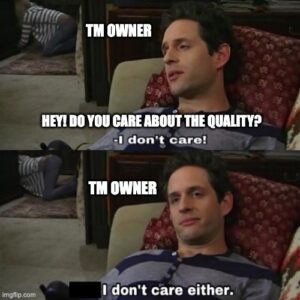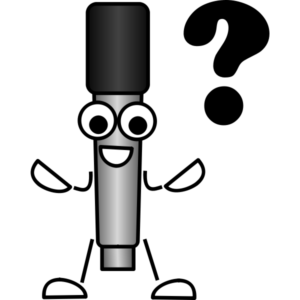People pulling opposite ends of rope flat vector illustration. Tug of war contest between office workers. Competition challenge and confrontation concept
” data-medium-file=”https://platoaistream.com/wp-content/uploads/2023/07/the-tussle-with-ncert-a-copyright-angle-1.jpg” data-large-file=”https://platoaistream.com/wp-content/uploads/2023/07/the-tussle-with-ncert-a-copyright-angle.jpg” decoding=”async” width=”1024″ height=”625″ src=”https://platoaistream.com/wp-content/uploads/2023/07/the-tussle-with-ncert-a-copyright-angle.jpg” alt class=”wp-image-41768″ srcset=”https://platoaistream.com/wp-content/uploads/2023/07/the-tussle-with-ncert-a-copyright-angle.jpg 1024w, https://platoaistream.com/wp-content/uploads/2023/07/the-tussle-with-ncert-a-copyright-angle-1.jpg 230w, https://platoaistream.com/wp-content/uploads/2023/07/the-tussle-with-ncert-a-copyright-angle-2.jpg 768w, https://platoaistream.com/wp-content/uploads/2023/07/the-tussle-with-ncert-a-copyright-angle-3.jpg 1536w, https://platoaistream.com/wp-content/uploads/2023/07/the-tussle-with-ncert-a-copyright-angle-4.jpg 2048w, https://platoaistream.com/wp-content/uploads/2023/07/the-tussle-with-ncert-a-copyright-angle-5.jpg 1200w, https://spicyip.com/wp-content/uploads/2023/06/7732659_5286-600×366.jpg 600w” sizes=”(max-width: 1024px) 100vw, 1024px”>
[This guest post is authored by Pranav Aggarwal. Pranav is a second-year student pursuing B.A.LL.B.(Hons) at Rajiv Gandhi National University of Law, Punjab. He has a keen interest in commercial laws, especially in IP and allied fields.]
The National Council for Educational Research and Training (NCERT), an autonomous body set up by the Government to ‘assist and advise the Central and State on policies and programmes for qualitative improvement in school education’. And as many readers would know, it has recently been in the midst of some controversy over unwanted attribution. On 8th June 2023, Suhas Palshikar and Yogendra Yadav requested NCERT to remove their names from NCERT’s Political Science textbooks for classes 9 to 12 (published in 2006-07) that they had been the Chief Advisors on. Subsequently, on 14th July 2023, other 33 academicians who were the members of the Textbook Development Committee in 2006-07 presented the same request. Their rationale was that the recent alterations in the books have highly ‘mutilated’ the essence of the original work ‘beyond recognition’ and they do not endorse the new work and hence do not want to be associated with them anymore. Subsequently, NCERT denied the request for removal of their names on the grounds that there exist no individual authorship and they had legally given all the rights to NCERT when the committee was terminated. Therefore, they cannot assert any right over it. This tussle may be called a political event, not unusual in the current political atmosphere. However, there lies a legal angle of copyright to this whole controversy which the current piece aims to explore.
Moral Rights of Authors
Before diving into the facets of the controversy, it is necessary to understand the essential principle of Moral Rights under Copyright law. Under the Copyright Act 1957 (hereinafter ‘Act’), several amendments were made in 1995 to bring the Act in line with the international conventions like Berne Conventions of 1886. Among various inclusions, Moral Rights or droit morals of the creators were also included in Section 57 of the Act. This provides a special right to the author for protecting his/her work even if the creator transfers the ownership and relinquishes all economic rights over the created work.
Section 57 (1) clarifies that this special right is independent of the author’s copyright on the work and Section 57(1)(b) clearly mentions that the author can restrain or claim damages from the other party for mutilating their work despite transferring all the rights to another party. The said provision was well established in the case of Amar Nath Sehgal v. Union of India as well where the Delhi High Court granted compensation to the artist whose mural, which was sold to the government along with transferring the copyright, was damaged and dumped subsequently. It was held that the instant mutilation had caused loss of reputation and mental injury to the artist which makes the party liable even when he ceases to have the ownership. A similar stance has been taken by the court recently in the case of Jatin Das v. Union of India (see here and here) where the court upheld the moral rights of the plaintiff, an artist and ordered a systematic restoration of the plaintiff creation by the defendants. Thus, by providing moral rights to the creators, the Act has secured and continues to secure the soul of the creation from being unreasonably altered or damaged.
Controversy and Its Dimensions
It is a settled principle of Copyright law that textbooks fall under ‘literary works’ as provided under the Act. Now, the question arises whether Palshikar, Yadav and others can be considered the authors of the work or not.
Under Section 2(d)(i) of the Act, the “author” under the Act in relation to a literary work is the author of the work. As far as NCERT political science books are concerned, the books do not mention anything about who the author is and therefore there is a need to look inside to infer authorship. Looking at the ‘Letter to the Reader’ (page no 5- 7), Yadav’s weekly address on his twitter handle, and the letter by the 33 members of the Textbook Development Committee (saying that the drafts were shared with the Chief Advisors who would suggest revisions to the chapters, if necessary) it can reasonably be inferred that Palshikar and Yadav are at least partial authors of the said books. Additionally, considering that 33 members of the Text Book Development Committee also made similar demands for removal of their names, further bolsters the presumption that these members are the authors of the books in some combination.
Another point to be noted is that these people were not under the contract of service with NCERT as they were still members of their respective institutions and the Textbook Development Committee was a commissioned work i.e. a contract for service. This makes them the first owner of copyright under Section 17 of the said act as well. However, it is undisputed that they have assigned this ownership completely when the purpose of the committee was consummated.
However, as noted above, though they might have transferred the ownership right of the textbooks to the NCERT, they still possessed the moral rights over it. The acknowledgement in the textbook points towards the Paternity Right i.e. the right to have the author’s name on the work which was given to them. If they had the right to be acknowledged in the work, they should also be given the freedom to not exercise such right, that is to say that they can refuse their association with the creation to save their own goodwill from being exploited. The exercise of such rights must solely depend upon the author.
But this is not how NCERT sees this whole situation. If we are to draw an analogy, NCERT, here, is acting more like a producer of the film by not recognizing the underlying rights of the creators at all. Even if we consider the arguments of NCERT that it was a collective work and no individual right exists, it has to be seen with a different lens. It has to be taken into consideration that the collective effort in a work does not eliminate the rights of the individuals as under the explanation given under Section 13(2) where copyright subsists for all the authors of a joint work. Therefore, legally speaking, excluding any pecuniary benefit, NCERT cannot deny the exercise of the special rights of the requesting members of the Textbook Development Committee.
The Way Forward
It can be accepted that not much has been deliberated and litigated on this issue of moral rights pertaining to situations as instant one. But even if we are not to consider any legal arguments in this matter, NCERT’s stance to deny such a request does not seem to be economically or morally detrimental to it but in the opinion of Palshikar, Yadav and others, it will cause damage to their reputation as being associated with something which no longer reflects them. It is clear that the recent rationalization of the textbook has changed or at least reduced the very nature of the textbooks that both of them had contributed to. Thus, omitting their names, which only has the function of acknowledging their efforts, shouldn’t be a problem for the NCERT to neutralize this issue and possibly restrain it from reaching the court.
- SEO Powered Content & PR Distribution. Get Amplified Today.
- PlatoData.Network Vertical Generative Ai. Empower Yourself. Access Here.
- PlatoAiStream. Web3 Intelligence. Knowledge Amplified. Access Here.
- PlatoESG. Automotive / EVs, Carbon, CleanTech, Energy, Environment, Solar, Waste Management. Access Here.
- BlockOffsets. Modernizing Environmental Offset Ownership. Access Here.
- Source: https://spicyip.com/2023/06/the-tussle-with-ncert-a-copyright-angle.html
- :has
- :is
- :not
- :where
- $UP
- 1
- 12
- 2023
- 7
- 9
- a
- About
- above
- accepted
- acknowledged
- Act
- acting
- Additionally
- advise
- advisors
- Aggarwal
- aims
- All
- along
- also
- altered
- amendments
- among
- an
- and
- Another
- any
- anymore
- anything
- ARE
- arguments
- artist
- AS
- associated
- Association
- At
- Atmosphere
- author
- authors
- Authorship
- autonomous
- BE
- been
- being
- benefit
- between
- body
- bolsters
- book
- Books
- both
- bring
- but
- by
- called
- CAN
- cannot
- case
- Cause
- caused
- central
- challenge
- changed
- chief
- claim
- classes
- clear
- clearly
- Collective
- combination
- commercial
- committee
- Compensation
- competition
- concerned
- Consider
- consideration
- considered
- considering
- contest
- continues
- contract
- contributed
- controversy
- Conventions
- copyright
- Council
- Court
- created
- creation
- creator
- creators
- Current
- damage
- defendants
- Delhi
- demands
- Despite
- Development
- different
- do
- does
- draw
- e
- Economic
- educational
- effort
- efforts
- eliminate
- endorse
- ends
- especially
- essence
- essential
- established
- Ether (ETH)
- Even
- Event
- excluding
- Exercise
- exist
- exists
- explanation
- exploited
- explore
- facets
- Fall
- far
- Fields
- Film
- First
- flat
- For
- Freedom
- from
- function
- further
- given
- Goodwill
- Government
- granted
- Guest
- Guest Post
- had
- handle
- Have
- he
- Held
- hence
- here
- High
- highly
- his
- How
- However
- HTML
- HTTPS
- i
- if
- improvement
- in
- included
- india
- individual
- individuals
- inside
- instant
- institutions
- interest
- International
- into
- IP
- issue
- IT
- ITS
- joint
- jpg
- July
- june
- Keen
- Know
- Law
- Laws
- least
- Legal
- legally
- Lens
- letter
- lies
- like
- Line
- ll
- longer
- Look
- looking
- loss
- made
- MAKES
- many
- Matter
- max-width
- May..
- Members
- mental
- mentions
- might
- moral
- more
- much
- mural
- must
- name
- names
- National
- Nature
- necessary
- Need
- New
- no
- noted
- now
- of
- Office
- on
- ONE
- only
- Opinion
- opposite
- or
- original
- Other
- Others
- over
- own
- owner
- ownership
- page
- party
- People
- pertaining
- piece
- plato
- Plato Data Intelligence
- PlatoData
- Point
- points
- policies
- political
- possibly
- Post
- presented
- principle
- Problem
- producer
- programmes
- protecting
- provided
- provides
- providing
- provision
- published
- pulling
- purpose
- qualitative
- question
- reaching
- readers
- recent
- recently
- recognizing
- Reduced
- reflects
- relation
- removal
- remove
- reputation
- request
- research
- respective
- restoration
- revisions
- right
- rights
- Said
- same
- Save
- say
- saying
- School
- Science
- Section
- secure
- Secured
- see
- seem
- seen
- sees
- service
- set
- Settled
- several
- shared
- should
- similar
- situation
- situations
- sold
- solely
- some
- something
- Soul
- speaking
- special
- State
- Still
- Student
- Subsequently
- such
- suggest
- taken
- textbook
- that
- The
- their
- Them
- There.
- therefore
- These
- they
- this
- though?
- to
- towards
- Training
- transferred
- Transferring
- transfers
- under
- underlying
- understand
- union
- university
- unusual
- unwanted
- upon
- various
- very
- want
- war
- was
- Way..
- we
- WELL
- were
- when
- whether
- which
- WHO
- whole
- whose
- will
- with
- Work
- workers
- would
- zephyrnet

